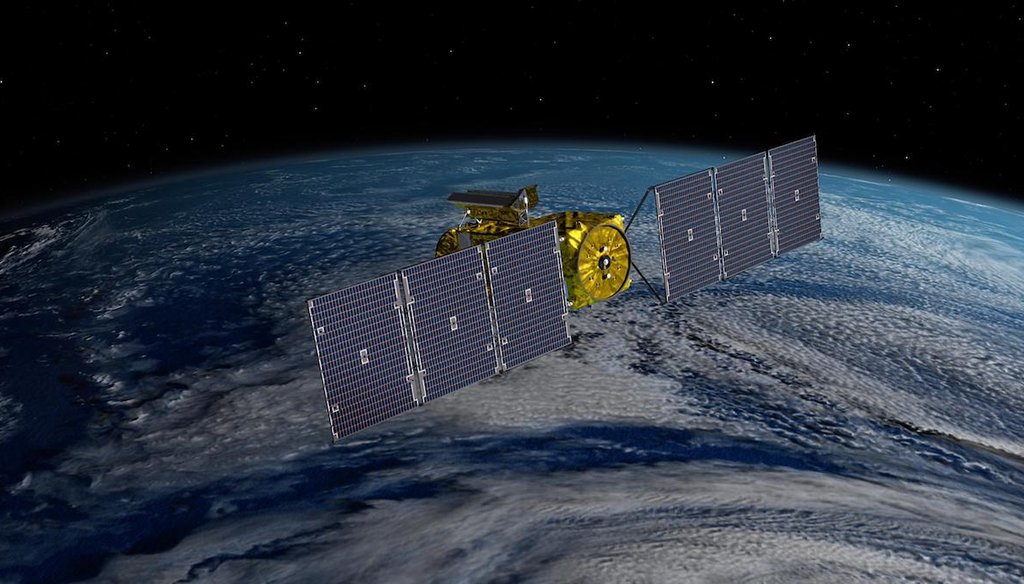

Our only agenda is to publish the truth so you can be an informed participant in democracy.
We need your help.


This 2022 illustration depicts the Surface Water and Ocean Topography (SWOT) satellite with solar arrays fully deployed. It is designed to provide high-resolution measurements of the water on Earth's surface. (NASA/JPL-Caltech)
High-altitude surveillance balloons are not the same as satellites, which are launched into space by rockets.
Satellites also orbit at much higher altitudes than balloon-powered devices.
Following news that a Chinese spy balloon was discovered flying over the United States, some social media users are floating other balloon-related conspiracies.
"‘Satellites’ are on balloons and not in space," claimed a Feb. 5 Instagram post that showed multiple photos of satellites that had supposedly crashed down to Earth.
"Satellites are never in outer space because there is no such thing," the caption read.
A Feb. 4 Facebook post made a similar claim: "Space is fake! Satellites hang from balloons."
These posts were flagged as part of Facebook’s and Instagram’s efforts to combat false news and misinformation. (Read more about our partnership with Meta, which owns Facebook and Instagram.)
Both posts also made references to the flat Earth conspiracy theory. NASA has emphatically reinforced indisputable evidence showing Earth is not flat.
PolitiFact has also debunked multiple claims that space is fake.
We conducted reverse-image searches of the photos in the Instagram post and found that most of the devices pictured are not satellites, but rather various scientific devices that used balloons to float. These devices were designed to study weather and bolster internet connectivity, among other functions.
Like the recently discovered Chinese spy balloon, these high-altitude devices are not the same as satellites.
High-altitude surveillance balloons have been used since World War II. Modern surveillance balloons typically hover around 80,000 to 120,000 feet above ground, according to Reuters. The majority of satellites orbiting Earth do so at altitudes between roughly 100 and 1,243 miles, although some satellites are as far as 22,370 miles away.
Most satellites ride into space on rockets. Propellants give rockets enough energy to lift off the ground, move against the pull of Earth’s gravity and fly into space.
These rockets release their passenger satellites at specific distances from Earth, depending on their intended orbits, according to NASA.
Once released, the momentum from the rocket will push the satellite out into space, while the pull of Earth’s gravity will help keep the satellite in orbit, NASA explained. Without this balance, the satellite would fly off into space or crash back down to Earth. Thousands of satellites orbit Earth, according to NASA. The Soviet Union launched the first satellite, Sputnik 1, into space in 1957.
While satellites can cost hundreds of millions of dollars to launch, high-altitude balloons can be relatively inexpensive.
Social media posts claimed satellites are on balloons and not in space.
There are high-altitude devices that use balloons to float, but they are not the same as satellites, which are launched into space using rockets.
The posts also claimed space is fake, which PolitiFact has repeatedly debunked.
We rate this claim Pants on Fire!
Instagram post, Feb. 5, 2023
Facebook post, Feb. 4, 2023
NASA, "How Do We Launch Things Into Space?," Jan. 26, 2023
How Stuff Works, "How Satellites Work," accessed Feb. 6, 2023
NASA, "What is a Satellite?", Feb. 12, 2023
Reuters, "Factbox: High-altitude spy balloons: old concept, new applications," Feb. 2, 2023
Aerospace Security Project, "Popular Orbits 101," June 14, 2022
PolitiFact, "No, this image of Earth isn’t from an Elon Musk/NASA leak," May 18, 2022
PolitiFact, "Outer space is not a ‘hoax’ as Instagram post claims," Nov. 1, 2022
PolitiFact, "A trick of perspective in NASA photos of the moon and Earth do not prove that space is fake," July 28, 2022
PolitiFact, "No, this video doesn’t prove space is fake," Sept. 9, 2022
Various reverse image searches, Feb. 6, 2023
The Verge, "Samsung’s ‘space selfie’ balloon crash-lands on Michigan farm," Oct. 28, 2019
NASA, "Australia Balloon Mishap Investigation," Aug. 13, 2010
Mexico News Daily, "Project Loon internet balloon crashes in Morelos," Feb. 4, 2019
PC Mag, "Google Project Loon Balloon Crashes in Chile," April 25, 2016
In a world of wild talk and fake news, help us stand up for the facts.
